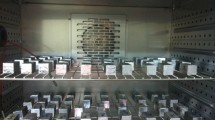Abstract
The coupled heat and moisture transfer in a freezing process of wood particle material was mathematically modeled in the paper. The models were interactively solved by using the numerical method(the finite element method and the finite difference method). By matching the theoretical calculation to an experiment, the nonlinear problem was analyzed and the variable thermophysical parameters concerned was evaluated. The analysis procedure and the evaluation of the parameters were presented in detail. The result of the study showed that by using the method as described in the paper, it was possible to determine the variable (with respect to temperature, moisture content and freezing state) thermophysical parameters which were unknown or difficult to measure as long as the governing equations for a considered process were available. The method can significantly reduces the experiment efforts for determining thermophysical parameters which are very complicated to measure. The determined variable of the effective heat conductivity of wood particle material was given in the paper. The error of the numerical calculation was also estimated by the comparison with a matched experiment.
Similar content being viewed by others
References
Farouki, O.T., 1986. Thermal properties of Soils. Trans Tech publications
Comini, G. and Del Guidice, S. et al, 1974. Finite Element Solution of Non-linear Heat Conduction Problems With Special Reference to Phase Change. Int. Journal for Numerical Method in Engineering. Vol. 8, P. 613–624
Crank, J., 1984. Free and Moving Boundary problems. Claredon Press. Oxford
Shang, D.K., 1989. Freezing Process of Wood Particle Aggregates. Research Notes no 136/ 1989,the Swedish University of Agricultural Sciencess.
Harlan, R.I., 1973. Analysis of Coupled Heat and Moisture Transport in Partially Frozen Soil. Water Res. Rsch., Vol. 9, No. 5, P. 1314–1323
Taylor, G.S., 1978. A Model for Coupled Heat and Moisture Transport during Soil Freezing. Can. Geotech. J., 15. 548–555
Jumikis, A. R., 1966. Thermal Soil Mechanics Rutgers. University Press, 66–18873, New Brunswick, New Jersey
Tauber, B.A., 1980. The Freezing of Comminuted Wood to The Walls of Containers. Lesn. Prom., No. 10,24-26
Nilsson, L., 1985. PC-FEMP, An Alternative, Graphic Finite Element Program System for Personal Computers. User’s Manual, Version 2. Engineering Research, Gransbov 29, S-59060 Ljungsbro, Sweden
De Vires, D.A., 1963. Thermal Properties of Soils. In Physics of plant Environment (W.R. Van Wijk, Ed.). Amsterdam: North-Holland Publishing Compang
Author information
Authors and Affiliations
Rights and permissions
About this article
Cite this article
Deku, S. Analysis of the thermophysical parameters of moist wood particle material in a coupled heat and mass transfer process of freezing by using finite element method. J. Northeast For. Univ. 2, 69–76 (1991). https://doi.org/10.1007/BF02874810
Received:
Issue Date:
DOI: https://doi.org/10.1007/BF02874810




